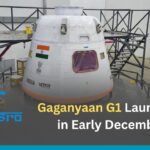Gaganyaan G1 Launching: ISRO says the first uncrewed Gaganyaan mission (G1) is on track for early December 2025, with ~90% of work complete and Vyommitra—the agency’s half-humanoid—flying to help validate crew-system performance. Over the past few months, teams have closed out “last-mile” tasks: a full-stack parachute deceleration demonstration (IADT-01), human-rating of the CE-20 cryogenic engine, harbour and well-deck recovery trials with the Indian Navy, and integration of the HLVM-3 human-rated launcher.
Below, a concise launch preview: what G1 will test, the flight-day flow, the safety envelope, and how this unlocks a 2027 crewed mission.
The Launch Window and What’s Flying
When: ISRO leadership has publicly indicated December first week for G1 after confirming that most work is complete; NewsOnAir reported the chairman’s update that 90% of tasks were done and subsystems had passed their checks.
Payload: Vyommitra, a half-humanoid, will ride inside the crew module to produce human-in-the-loop data (cabin environment, alerts, speech/telemetry interactions, panel ops) and to exercise life-support interfaces in flight. ISRO and mainstream reports through Aug–Sept 2025 clarified that Vyommitra will fly on G1, not just later uncrewed missions.
Vehicle: HLVM-3 (human-rated LVM3) lifts G1 from Satish Dhawan Space Centre, Sriharikota. It adds redundancy, stricter qualification and a Crew Escape System (CES) that is active from pad through the dense-air regime, enabling safe ejection of the crew module in an off-nominal ascent.
What G1 Intends to Prove (and Why It Matters)
System validation in orbit: Although uncrewed, G1 is the first time ISRO flies the orbital crew module + service module stack on a human-rated launcher, collecting data on thermal, structural, GN&C, power and ECLSS (environmental control & life support) behaviours in space. The mission sits squarely inside the broader Gaganyaan programme to put Indian astronauts in ~400-km low Earth orbit and bring them back to a splashdown in Indian waters.
Risk retirement for crewed flight: Every subsystem cleared on G1 reduces the risk budget for the crewed mission, planned for 2027 per government and media briefings; recent policy notes have reiterated that the uncrewed flights precede that milestone.
Last-Mile Tests: What’s Recently Been Qualified
Parachute System — IADT-01 (Full End-to-End Drop)
On Aug 24, 2025, ISRO executed Integrated Air Drop Test (IADT-01) at SDSC, demonstrating the apex cover, drogue, pilot and main parachute sequence that slows and stabilises the crew module to splashdown. The test validated end-to-end performance of the deceleration system in a representative scenario.
The parachute hardware was developed by DRDO’s ADRDE (Agra); deliveries and additional tests for the uncrewed flight were reported earlier this year. Government broadcasters also highlighted main-parachute load tests under extreme scenarios.
Cryogenic Engine (CE-20) — Human-Rating Completed
ISRO completed human-rating of the CE-20—the cryogenic engine that powers HLVM-3’s upper stage—after a long series of vacuum ignition and hot-fire trials; the final qualification was recorded on Feb 13, 2024 at IPRC, Mahendragiri. This closes a critical reliability gate for human spaceflight.
Recovery — Indian Navy Harbour & Well-Deck Trials
Since 2023, ISRO and the Indian Navy have rehearsed harbour recoveries and well-deck operations (bringing a floating capsule into a ship’s floodable deck), including drills off Visakhapatnam. These trials refine towing, lifting, crew extraction and medical handover—steps that must run like clockwork after splashdown.
Launcher and Stack Integration
ISRO opened the G1 launch campaign by assembling HLVM-3 and mating mission elements at Sriharikota. (The agency notes HLVM-3 is derived from LVM3 with enhanced reliability, redundant avionics and CES.) Ancillary propulsion milestones for the service module have also been reported in the run-up.
Launch-Day Flow: What to Watch (Indicative Sequence)
While exact T-timelines are published closer to launch, a typical HLVM-3 ascent features:
(1) Liftoff on twin HS200 solids + L110 core; CES remains armed through the atmospheric phase. (2) Booster separation, core-stage shutdown and C25 cryogenic ignition. (3) Payload fairing separation in thinner air. (4) Orbital insertion and early checkouts of GN&C, power, thermal and ECLSS. (5) On-orbit operations and de-orbit culminating in parachute sequence to splashdown and Navy recovery. (Flow per ISRO launcher & recovery documentation).
Expect an ISRO webcast link on the official site/socials and media advisories on the L-24 hr countdown. (ISRO typically posts the precise T-0 and streaming details close to launch.)
Who (and What) Makes Up the Spacecraft
Crew Module (CM): Pressure vessel, avionics, thermal protection, ECLSS interfaces; HAL is a key manufacturer for CM structures. Vyommitra will interface with displays and sensors to log “human-equivalent” responses.
Service Module (SM): Electrical power, service module propulsion, communications, attitude/orbit control. ISRO reported completion of core SM propulsion development earlier this year, part of the broader readiness drive.
Parachute & Floatation: DRDO-ADRDE’s 10-parachute cluster (apex cover separation, drogue, pilot, main) brings the CM to safe splashdown; IADT-01 stitched those pieces into a realistic end-to-end trial.
Why Vyommitra Matters on an Uncrewed Flight
Sensor-rich surrogate: Vyommitra collects environmental and operational data—cabin pressure, CO₂, temperature, acoustic and vibration loads—and can acknowledge alerts or toggle panels under ground command. That dataset helps tune ECLSS and human-factors thresholds ahead of crewed operations. ISRO leadership confirmed in briefings that Vyommitra will indeed fly on G1.
Public engagement: A visible “crew surrogate” keeps the public focused on safety and systems—not just spectacle—underscoring that India’s first human mission will only fly after fully-closed risk gates.
Safety Architecture: Human-Rating, Redundancy, Abort
Human-rating of HLVM-3 forces rigorous derating, redundant avionics, and exhaustive testing (e.g., CE-20). CES gives an abort option from the pad to high-altitude ascent; parachute & recovery systems are now proven in integrated demos with the Navy. Together, these create layered escape and survival paths.
The Roadmap After G1
Government briefings indicate additional uncrewed flights and test-vehicle abort missions before India attempts a crewed launch, now targeted for 2027. Budgetary updates this year also reflected a scaling-up of the human spaceflight envelope and downstream ambitions (e.g., a national space station in the 2030s).
Industry and Inter-Agency: Who’s Contributing
HAL (crew module structures), DRDO-ADRDE (parachutes), IPRC (engine tests), VSSC/HSFC (vehicle & human-spaceflight directorates), and the Indian Navy (recovery) are key. Harbour and well-deck rehearsals are now standard playbook, with divers, medics and deck crews drilled on timelines and hand-offs.
A values lens that fits the mission
Engineering with conscience
Gaganyaan demands technical excellence—and moral clarity about safety. Sant Rampal Ji Maharaj spiritual discourses often stress truthfulness, non-harm and service. In spaceflight, that ethic looks like transparent testing, redundancy over bravado, and placing life above schedule pressure. As India readies for crewed flights, the quiet discipline to “do the right thing even when no one is watching” is as vital as any thrust figure.
Read Also: ISRO’s Gaganyaan Mission Achieves Major Milestone with Successful Parachute Drop Test
FAQs: Gaganyaan G1 Launching
1) What is Gaganyaan G1 and when is it launching?
G1 is the first uncrewed orbital test of India’s human-spaceflight spacecraft. ISRO leadership has indicated an early December 2025 launch window, with ~90% work completed as of late October.
2) Is Vyommitra definitely flying on G1?
Yes. The ISRO chairman has said the half-humanoid Vyommitra will fly on G1 to generate human-equivalent data and test interfaces, not just on later uncrewed missions.
3) Which rocket is being used?
The HLVM-3 (human-rated LVM3), with Crew Escape System active from pad through ascent’s dense regime; it adds redundancy and stringent qualification over the baseline LVM3.
4) What recent tests closed the “last-mile” gap?
A full parachute end-to-end drop (IADT-01), CE-20 human-rating, and Navy recovery trials (harbour/well-deck). These de-risk descent and post-splashdown operations.
5) What orbit and duration should we expect?
G1 aims for low Earth orbit operations (detailed target and duration are typically confirmed in the L-24 hr press note). The programme baseline is ~400 km LEO for the eventual crewed flight.
6) When will India fly astronauts?
Government/ISRO timelines point to a 2027 crewed mission after uncrewed flights and abort tests are completed; funding and test cadence were updated in 2025.
7) Who handles recovery at sea?
The Indian Navy, working with ISRO, has rehearsed towing, lifting and medical hand-off through harbour and well-deck trials.










